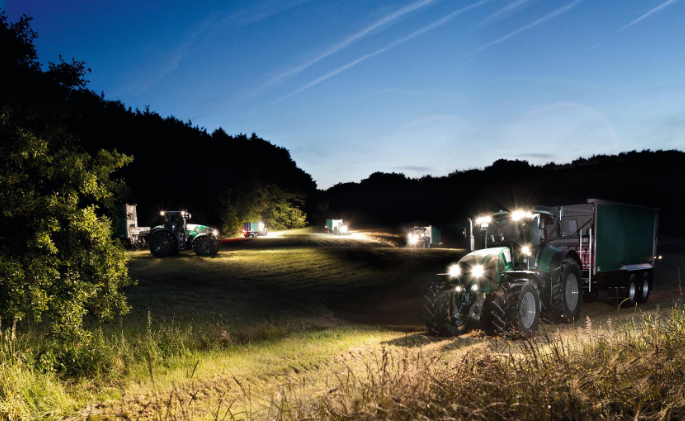Benefits of using LED lamps for Agricultural Vehicles
We all think we know the value of warning lights, in the form of beacons and BST-flashers. We flick the switch and carry on as usual; it’s an automatic action, something we don’t necessarily analyse. And that means farmers and vehicle operators could be missing out. HELLA is a global leader in lighting and electronic components for vehicles and offers an impressive range of general and specialist lights designed specifically for the agriculture and forest and grasscare industries. With HELLA’s help, we’re taking a look at how LEDs can be used for beacons and BST-flashers as well as worklights and headlamps.
“BST-flashers are unique flashers from HELLA. These highly functional BST flashers have a compact design and are equipped with efficient LED technology.”
What are the advantages for agricultural vehicles of LED lights instead of halogen or xenon lights?
LED lights offer some significant benefits to farmers and vehicle operators. Let’s look first at productivity, efficiency and safety. LED headlamps and work lights offer very obvious safety and efficiency advantages; white LEDs can be specified in neutral (3300-5000 Kelvin colour temperature) and daylight white (5000+ Kelvin colour temperature), as well as warm light (below 3300 Kelvin colour temperature). Worklights and headlights in daylight white are shown to offer more light, for a greater distance, and over a wider field of vision, than the warm light emitted by halogen bulbs in particular. This means greater visibility for close working and, when driving, into the distance. Being able to see more clearly brings clear benefits in terms of how productive you can be, how quickly and efficiently you can work, how accurate your work is, and how confidently you can drive or manoeuvre safely.
 "Worklights and headlights in daylight white are shown to offer more light, for a greater distance, and over a wider field of vision, than the warm light emitted by halogen bulbs in particular."
"Worklights and headlights in daylight white are shown to offer more light, for a greater distance, and over a wider field of vision, than the warm light emitted by halogen bulbs in particular."Just as significantly, having that improved, brighter light in daylight white brings an extra benefit: it’s proven that the closer artificial light gets to daylight, the less likely a driver or operator is to feel fatigued. That’s not just a comfort concern, it’s a serious safety benefit. Tired drivers and equipment operators are more likely to make mistakes and cause damage. LED lighting, particularly in daylight white, makes for more successful and safer farming.
There are financial benefits, too. While buying LED lamps is typically more expensive, the average lifespan of the light is increased radically. HELLA’s LED lights achieve a lifespan of 30,000 operational hours or more, whereas conventional halogen lights usually last between 2,000 and 4,000 hours. That’s as much as 15 times longer between an inconvenient and disruptive lamp’s replacement, and is likely to be more cost-effective across each light’s lifetime – before you even consider the cost of having to stop working more frequently. As LED lamps in beacons, BST-flashers, headlights and work lights become more and more commonplace, the cost of replacement is also likely to come down, giving farmers even greater savings. New LED lamps come as integrated units, suitable for both 12V and 24V installations.
They are also less vulnerable to damage through impact or vibration. Given the variable terrain of fields and farmland, choosing LED lights is the wiser move if you want to reduce the risk of unforeseen stoppages and extra expense.
LED lights even have an impact on how efficiently your machinery operates. Halogen and xenon lamps draw more power away, to produce less efficient light and needless heat, which means less incrementally less power for the machine, which has to work harder to do its work. It may seem a small impact, but over time this could have a bearing on the longevity of various parts, particularly the service life of the battery. Fuel efficiency suffers, too, if you’re not using LED lights.
Then there are the obvious environmental benefits, with less vehicle fuel burnt, less energy spent and wasted in use, less energy wasted in the production of lamps with shorter lifespans, less waste that needs recycling or disposing of safely, no mercury content, and a smaller carbon footprint for the farm itself because of reduced CO2 emissions.
Can you retrofit LED lamps to older vehicles or convert halogen lamps to LED lamps?
Absolutely, subject to availability and suitability of the vehicle in question. Retrofitting is the more straightforward option, with specialists providing LED headlamp alternatives for many existing brands and specific vehicles.
You will also find information and videos online offering instructions on converting halogen lamps to LED. There are lots of essential safety considerations to factor in, however, including EMC interference, vibration, overheating protection, decoupling and reflectors to ensure the correct splay of light. The cables used must be of the correct thickness; simply using your existing lamp’s cabling would carry a very real risk of fire because of power overloads. We would always advise going to a reputable specialist in conversion work to make sure that the job is done correctly and safely and that the converted lights adhere to all legislation.
Choosing LED lamps for beacons and BST-flashers
There are more rotating beacons and BST-flashers with LED technology available than ever before and the prices are extremely favourable.
The primary purpose of any beacon or flasher is to create awareness of a hazard. Both the speed at which the light first comes on, and the reach and visibility of that light, matter.
LED lights react instantly, achieving their full strength immediately. Halogen and, in particular, xenon lamps, take time to warm up. In emergency situations, this time difference should not be overlooked.
For the most part, though, your beacons – whether rotating or flashing – are there for ongoing awareness. Their reach matters. The further away they can be seen, the safer any given situation becomes.
The greatest advantages of choosing LED BST-flashers and beacons, though, come from their reliability, durability, longevity and increased cost efficiency. As we established earlier, halogen lamps in particular have a greatly reduced lifespan compared to LEDs. They’re more vulnerable to vibration and impact damage and, over time, the costs can soon stack up.
Can I replace fitted halogen beacons and BST-flashers with LED versions?
HELLA is replacing its old range of beacons and BST-flashers on a like-for-like basis. That means that the new, improved LED versions are designed to fit the same holes, for fuss-free replacement.
The range covers every flasher and beacon need for agricultural machines. The most basic version, the Rota Compact LED, will happily resist dust or water from pressure washers, and features HELLA’s impact-resistant, high-performance technology. The K-LED Nano is HELLA’s most affordable and smallest homologated flasher beacon has impressive light intensity and can withstand significant vibration. Other options to choose from include the Rotaflex, the Rota LED, the RotaLED Compact – which contains no moving parts – and the most futuristically styled of them all, the K-LED Rebelution. The K-LED Rebelution has a short profile to avoid issues with height restrictions, and you can choose either rotating or flashing light options. The light is even dazzle-free. Head to the HELLA product page on the Kramp web shop to find out more.
For more information about LED beacons, BST-flashers and work lights and to find out which are best suited to your vehicles and working conditions you could check our web shop and the other Knowledge Center lighting articles.

